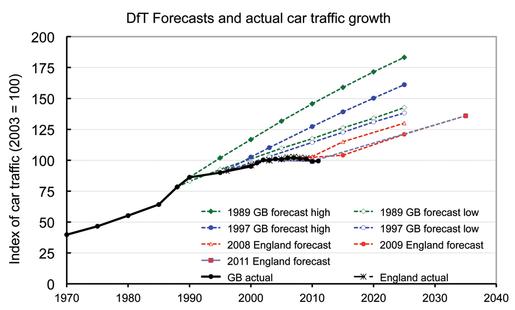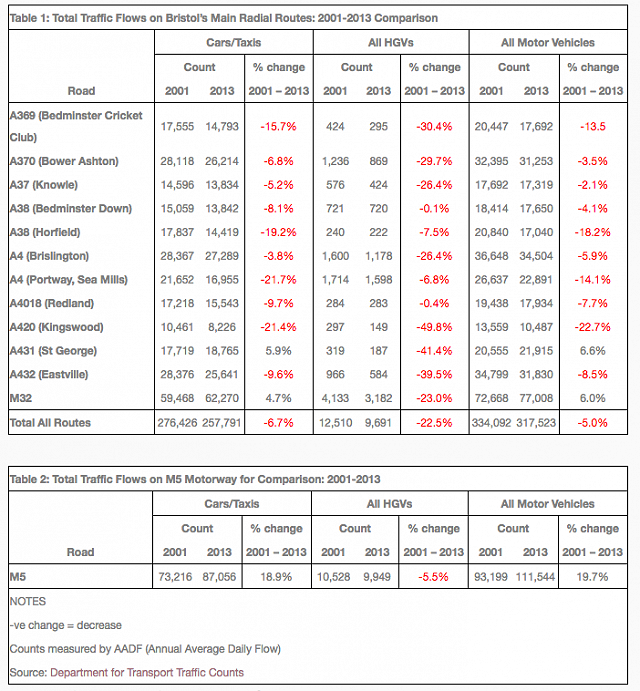As a commuter, a Professional Transport Planner, chairman of the Business West Transport Group and sometime advisor on the Mayor of Bristol’s Transport Group, I often hear complaints about the state of our roads, the levels of congestion in Bristol, the impact these things have on the success of the city and the well-being of those who live and work in and visit the area. But are Bristol’s transport problems really that bad and, if they are, what should we do about them? In the first of a series of three blogs I attempt to summarise the current situation on our roads. In the second blog I will compare Bristol to contemporary cities in England and on the continent and in the third I’ll offer some thoughts on how Bristol’s transport systems will need to change in future.
Is it fair to complain about transport and travel in Bristol?
On the flight back from a recent weekend in Prague I started to think about my travelling experiences in that city and that led me to contemplating related issues in Bristol. [Ok, I accept I’m a transport anorak!!]
In Prague the taxi whisked my party along an uncongested dual carriageway all the way from the airport, through a tunnel and across a river bridge that delivered us, in under 20 minutes, right into the heart of the city centre. During the weekend we strolled around the Medieval city centre, passing through several wonderful pedestrianised squares, crossed a far-too-busy 15th century pedestrian bridge, and used trams that criss-crossed the city centre and were easy to understand. Overall our experience of Prague was very pleasant…….yet we encountered congested traffic at what seemed like every second road junction. In fairness the taxi journey was late at night, so it’s no surprise it was uninterrupted and the Charles Bridge is one of Prague’s main tourist attractions, so it was always going to be heaving with people. As in Bristol, the pedestrian squares were a pleasure to visit but the trams were better than any public transport we have in Bristol and the daytime traffic congestion seemed much the same.
Now I seldom visit Bristol as a tourist, so it’s not possible to draw direct comparisons but it did make me think about Bristol. I come into the city on most weekdays and, going about my working life, I seem to hear constant complaint about one aspect of travel or another: the traffic is too congested; the buses run late and are expensive; the 20mph speed limits are ridiculous; the residents’ parking schemes are either brilliant or a disaster, depending on who you talk to; the cycle routes don’t join up; cyclists cut up pedestrians on footways; the trains are over-crowded; and so on and so on. So I began to ask myself, is it really that bad in the city I’ve made my home? And if so, what should we do about it?
Well here are some deliberations around those questions, which I hope will, at least, make you think and perhaps might change your perception of the city.
Is it really that bad?
To address this question I started with my daily commute, which I’ve done ever since I moved out of Bristol to Wrington in 1987. Wrington sits in the valley beyond Bristol Airport midway between the A38 and A370, so over the years, depending on office location and changing traffic conditions, I have switched between using each of these routes into the city, and sometimes both, cutting across from the A38 through Barrow Gurney to use the A370 Long Ashton Bypass.
When I thought about my commute, I realised to my surprise that my journey into Bristol is no worse now than it was when I worked in the heart of Clifton Village back in 1995, although my return journey does take a little longer. Back in 1995, if I left the house by 7.25am, I would usually be in the office by 8.00am and today, on most days, it’s much the same to get to Key Transport’s office in Berkeley Square. In fact, traffic on Mondays and Fridays has become noticeably lighter, so on those days the morning commute is usually quicker, often with a delay free run right through the Cumberland Basin and on into the city. In contrast, I think my return journey has got slightly longer. I put that down to more traffic coming back into the city from the Airport’s afternoon rush hour, causing more delays, particularly in Barrow Gurney. So I’ve changed my route lately and now make a nuisance of myself driving past more houses on the A370 through Flax Bourton, Backwell and Cleeve than I used to pass on the route through Barrow Gurney and the A38.
Overall, my experience as a car commuter coming into the city from the south-west has varied only marginally in the last 20 years or so. In my view, it remains acceptable and provides no real grounds for complaint.
That being the case, I wondered how that could be because my personal experience conflicts with the Department for Transport software that we use in my industry, which tells us routinely to plan for traffic growth.
The chart shows a comparison of DfT forecast traffic growth against actual traffic growth over the past 25 years, and was produced by Professor Phil Goodwin in 2012 in a comment piece written for Local Transport Today. Even if you ignore the recent recession years, a general levelling off of car use can be seen, which mirrors my experience of commuter traffic flows in Bristol. Yet going forward the DfT are still forecasting significant increases in car traffic over the next 25 years.
For more details visit http://www.bettertransport.org.uk/campaigns/roads-to-nowhere/ltt-130412

To find out more I looked back at published DfT records of the traffic on the main radial routes into Bristol. The result certainly surprised me and may surprise you – there was less traffic on many of those roads in 2013 than in 20011. The full information is provided in Table 1 below. For good measure I also provide the same figures for the M5 west of Bristol in Table 2, where, interestingly, traffic has increased significantly.

I think the figures speak for themselves. Overall car and taxi trips on these radial routes of Bristol have fallen in the period by an average of 6.7%, HGVs have fallen by 22.5% and the overall reduction for all traffic is 5.0%. Only in the north and east, on the M32 and A431, have the flows increased, and it may not be a coincidence that these serve the areas of Emersons Green, Bradley Stoke and Yate, where much of the city region’s 10% of housing growth has taken place.
These figures sit comfortably alongside my own commuting experience and I’m grateful for that: it means the local highway authorities have got something right. Maybe one factor is the ring of park and ride sites that serve the south and west of the city. But pity those living north of the city. They have benefited from some improvements to bus services through the Greater Bristol Bus Network package that might enable some to leave their car at home. Yet they still don’t have the option of a park and ride on the M32 and they have to wait till 2017 for delivery of the North Fringe to Hengrove Metrobus before they have any hope of meaningful relief. Even then, the scheme won’t deliver a park and ride.
Coming back to my starting question with respect to road traffic the answer seems to depend on where you live. Luckily I seem to have chosen to live on the “right side” of the city but I suspect those living to the north and east will see things very differently, especially as it only takes a few percentage points of change in traffic flow to make the difference between a congested and uncongested network.
Delving a little further into my commuting practice I thought about the impact of my car journey on the residents of the city and of those who live along my routes to and from work. I don’t think congestion levels are significantly different on these corridors, so that’s a nominal impact on the residents. Indeed, the data in Table 1 for the A38 and A370 south of the city suggest an improvement, albeit these are daily flows rather than peak hour flows. Furthermore, for those affected by my switch to the A370 for my return journey there is good news because it won’t be long before the South Bristol Link, promoted jointly by North Somerset and Bristol City Councils, will connect the A370 and A38 and provide a bypass to Barrow Gurney. When that road opens, I’ll switch onto it and will no longer cause a nuisance to the residents of Barrow Gurney, Flax Bourton, Backwell or Cleeve. That means brownie points to the Councils for finding a route that they could jointly promote after earlier disagreements, and to Bristol Chamber of Commerce and Initiative for keeping the scheme alive fifteen years ago when Bristol proposed to drop the reserved corridor in south Bristol from its Local Plan.
I then thought about vehicle emissions. Back in 1995 I drove a car that did around 25 to 28mpg on the daily commute whereas, with the help of improved engine technology2, yet without sacrificing the utility afforded by the particular vehicle, my current car does a remarkable 55 to 60mpg. So grossly over-simplifying, my carbon footprint and my impact on air quality for those residing along my route may have roughly halved. This means that if I’m anywhere near typical, air quality should have improved on two counts on most routes into the city because there are fewer vehicles and those that are there are cleaner.
To find out about this issue, I looked at Bristol City Council’s 2014 Air Quality Progress Report3, which provides a summary of the air quality data collected in 2013. Bristol currently has an Air Quality Management Area (AQMA) in place extending across most of the city centre and out along various radial roads4, as can be seen in the adjacent image (click for larger version). The continued existence of an AQMA indicates that changes in traffic flow and the use of more fuel efficient vehicles has not yet resulted in improvements to the city’s air quality to the extent that it falls below the required European standard [EU limit value set for the protection of human health (40 microgram NO2/m3 annual mean and to be met by 2010)]. Indeed reviewing the data set out within the report reveals that approximately 60 of the 103 monitoring sites within the AQMA recorded annual mean NO2/m3 levels in excess of the target. Outside of the AQMA the report notes that readings taken at non-permanent sites on Blackboy Hill, Whiteladies Road and in Avonmouth raised concerns, but not enough to justify an extension of the AQMA.
However, while the BCC report acknowledges that there is a long way to go, there is also a suggestion that air quality is generally improving. Rupert Street in Bristol is noted as having the highest concentration of NO2 concentrations of any continuous analyser within Bristol, but the records for 2013 show a significant improvement over the results for 2008. In 2008 there appear to have been 285 hours when the concentration of NO2 exceeded 200 micrograms NO2/m3 but in 2013 this had reduced to 56 hours.
All this is a simplistic view and my lack of knowledge of the complex world of air quality assessment doesn’t allow me to speculate further on the subject. So if you know more and would like to comment, do feel free to respond, especially if I’ve got it all wrong.